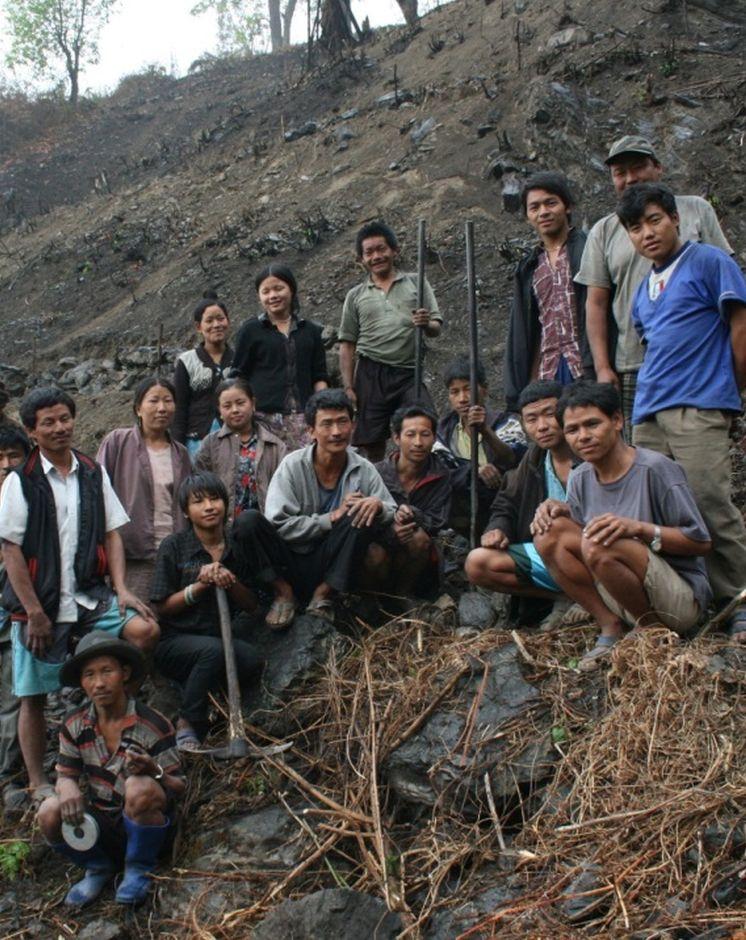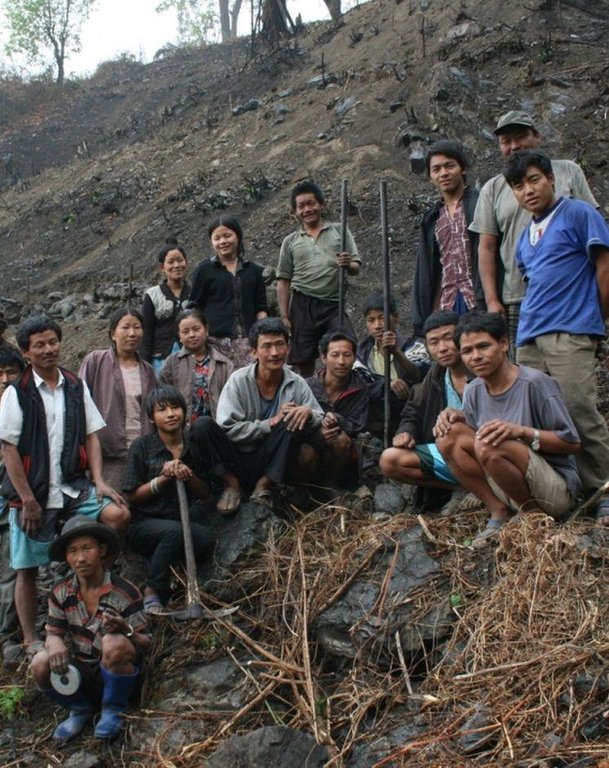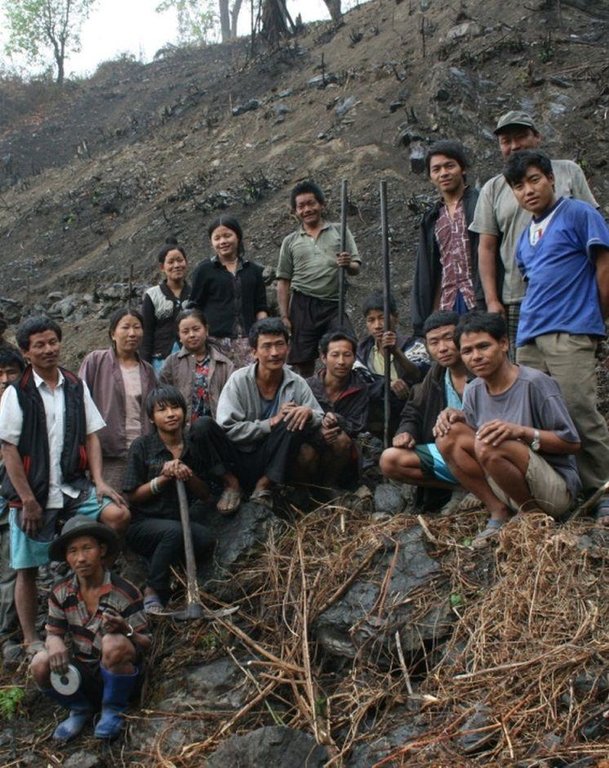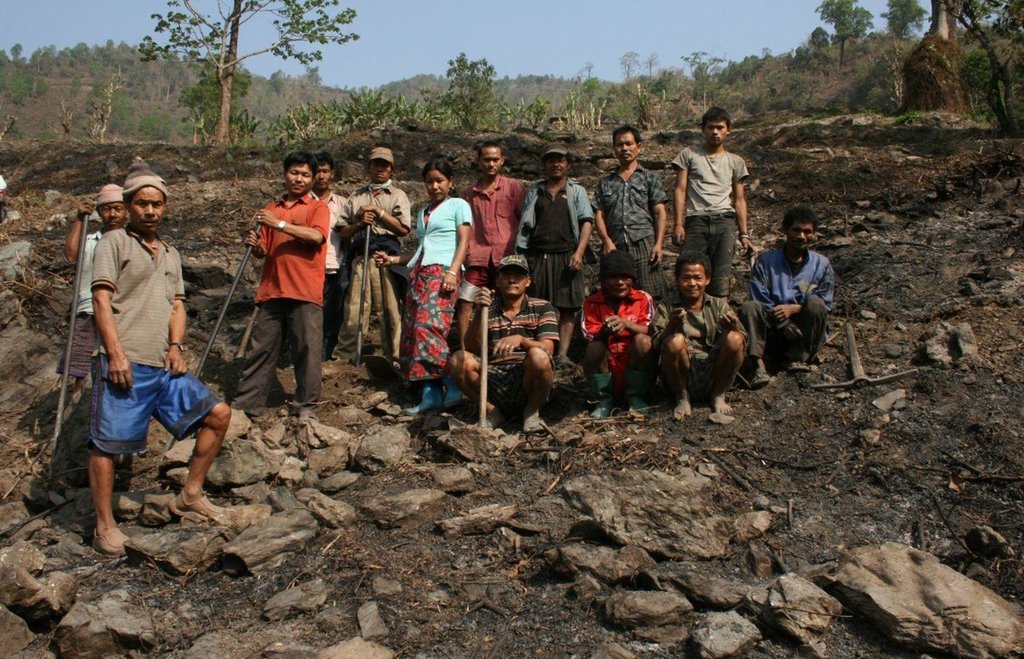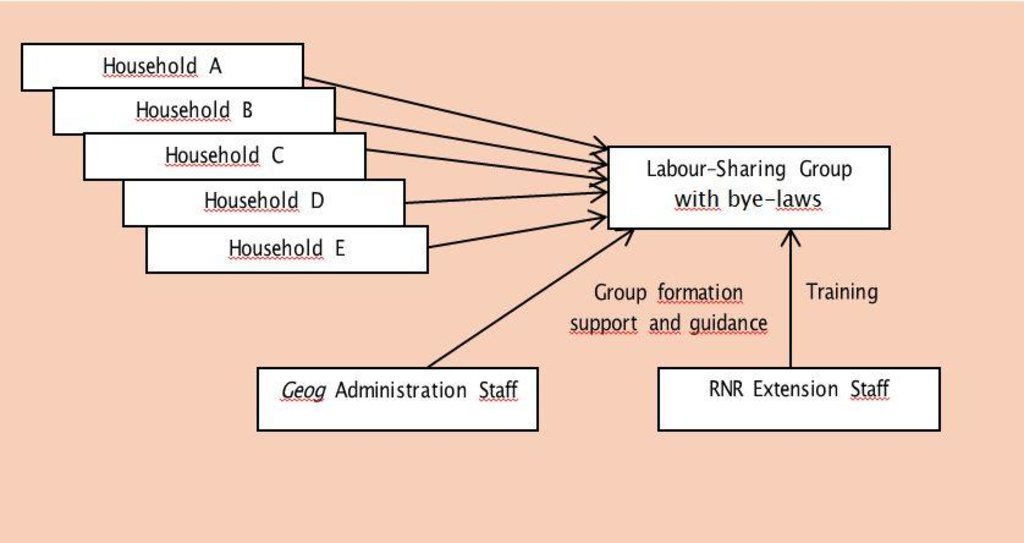SLM Labour-Sharing Group [Бутан]
- Создание:
- Обновить:
- Составитель: Karma Dorji
- Редактор: –
- Рецензент: Fabian Ottiger
approaches_2491 - Бутан
Просмотреть разделы
Развернуть все Свернуть все1. Общая информация
1.2 Контактные данные специалистов и организаций, участвующих в описании и оценке Подхода
Название организации (-ий), содействовавших документированию/оценке Подхода (если применимо)
MoA (MoA) - БутанНазвание организации (-ий), содействовавших документированию/оценке Подхода (если применимо)
National Soil Services Centre (National Soil Services Centre) - Бутан1.3 Условия, регламентирующие использование собранных ВОКАТ данных
Когда были собраны данные (на местах)?
21/03/2011
Составитель и ответственный/-ые специалист(-ы) согласны с условиями, регламентирующими использование собранных ВОКАТ данных:
Да
1.4 Ссылка (-и) на Анкету (-ы) по Технологиям УЗП
2. Описание Подхода УЗП
2.1 Краткое описание Подхода
Labour-sharing group at village and sub-village level to ease the labour constraint faced by many households.
2.2 Подробное описание Подхода
Подробное описание Подхода:
Aims / objectives: A labour-sharing group is a pool of land-users, who work on rotation basis on the plots of the different group members and replaces the conventional approach of an individual land user carrying out a specific SLM intervention. An important constraint for effective implementation of SLM interventions is the lack of sufficient labour force at household level. To tackle this key issue, groups are formed at village and sub-village level to enable these households to take up the relatively labour-intensive SLM activities, such as stone bunding, bench terracing, stone check dam construction, water source protection works or grass hedgerow development.
Methods: The labour-sharing group is given an initial practical training on the basics of the SLM intervention, which start with hands-on work on the land of a group member, preferably that of a vulnerable household, which otherwise would have difficulty to provide sufficient labour to take up the activity. Labour-sharing groups therefore facilitate the inclusion of vulnerable households, especially female-headed and small families, in the implementation of labour-intensive SLM inter-ventions. In addition to the technical guidance provided by the extension staff, support is given to the group formation process, such as drafting of informal by-laws and group management.
Stages of implementation: Labour-sharing groups enable households to carry out key SLM interventions more effectively and efficiently enabling them to cover as compared to individual household approach. Other co-benefits reported are the improved community sense and enhanced social cohesion, because the exchange of experiences and collaboration builds mutual trust. Working in a group eases hard physical work, such as carrying and breaking large boulders and is perceived to be much more enjoyable than working alone or in a small household setting.
Role of stakeholders: Groups that were formed for the implementation of a specific SLM activity often continue carrying our other planned SLM interventions in a group. In some villages communities reported that they had lost the former practice of labour-sharing, but that with reintroduction by the project their community sense has been rejuvenated. Sustainability of the labour-sharing approach has to be proven post-project. Additional costs are very limited and are restricted to group formation guidance and some additional group support, such as tool sets and more incentives as more land will be converted by the group approach.
2.3 Фотографии, иллюстрирующие Подход
2.5 Страна/ регион/ место, где применялся Подход
Страна:
Бутан
Административная единица (Район/Область):
Chhukha Dzongkhag
Более точная привязка места:
Logchina geog, Amallay chiog
2.6 Даты начала и окончания реализации Подхода
Год начала реализации:
2009
Год окончания (Если Подход больше не применяется):
2012
2.7 Тип Подхода
- в рамках проекта/ программы
2.8 Каковы цели/ задачи Подхода
The Approach focused on SLM only
- To ease the existing labour constraint of individual households by pooling labour force into a common pool, ensuring a more time-efficient labour approach, enabling the group to convert larger areas of land.
- To facilitate the inclusion of vulnerable households in more labour-intensive long-term SLM interventions, for which they otherwise would not have the meansto participate.
- To improve community cohesion through improved trust, understanding, social fencing and “labour joy” (“it is much more fun to work in a group than to sweat individually”).
The SLM Approach addressed the following problems: - SLM interventions, as prioritized in chiog SLM action plan, are very labour-intensive, while labour is increasingly becoming a serious constraint in many rural areas of Bhutan, because of rural-urban migration, off-farm labour and other developmental activities.
- Vulnerable households, single-headed families and poorest families, have often the most difficulty providing sufficient labour for long-term SLM interventions
- Communities often face problems in achieving the targeted area of land to be converted to a more sustainable SLM practice, because of labour shortage.
2.9 Условия содействующие применению Технологии/ Технологий в рамках Подхода или затрудняющие его
Социальные/ культурные/ религиозные нормы и ценности
- затрудняют
Some issues with households who do not share sufficient labour / fail to show up
Treatment through the SLM Approach: Informal by-laws, penalty system, social fencing
Нормативно-правовая база (землевладение, права на земле- и водопользование)
- содействуют
The existing land ownership, land use rights / water rights greatly helped the approach implementation: Individual titled land tenure greatly facilitates motivation and commitment of households to participate in group approach as they are direct beneficiaries.
Объем работ, доступность рабочей силы
- затрудняют
SLM interventions often require considerable hard physical labour, in a society where labour force increasingly is becoming scarcer.
Treatment through the SLM Approach: Pool individual households in a group and work on rotation basis on each other’s land
3. Участие и распределение ролей заинтересованных сторон
3.1 Заинтересованные стороны, участвующие в реализации Подхода и их роли
- местные землепользователи/ местные сообщества
self initiative during planning cycle
Slight differences in participation level in the most physically challenging activities such as stone bunding, but also partly culturally determined if there is gender bias in participation. In less physically demanding activities participation is equally divided.The most vulnerable households are included in the labour-sharing group, just as the “better off” families; inclusion of vulnerable households is definite advantage of approach, and an important objective.
- эксперты по УЗП/ сельскому хозяйству
- местные власти
Local government (geog staff, chiog representatives) and local community
- государственные власти (отвечающие за планирование или принятие решений)
3.2 Участие местных землепользователей/ местных сообществ на разных стадиях реализации Подхода
| Участие местных землепользователей/ местных сообществ | Перечислите участников и опишите их вовлеченность | |
|---|---|---|
| инициирование/ мотивация | интерактивное | Participatory SLM Action Planning |
| планирование | интерактивное | Participatory SLM Action Planning; Schedule of rotation compiled by group members |
| выполнение | интерактивное | Training / capacity building at kick-off of group formation process; stone bunding, hedgerow establishment, bench terracing, stone check dam construction, bamboo and tree plantation, water source protection works and grass strip establishment |
| мониторинг/ оценка | интерактивное | Participatory Monitoring & Evaluation meetings to give feedback and make adjustments / give guidance |
| Research | нет |
3.3 Схема реализации (если имеется)
Описание:
Labour-sharing group and its governance
Автор:
Hans van Noord (Schoutenkamp 43 Heteren The Netherlands)
3.4 Принятие решений по выбору Технологии/ Технологий УЗП
Укажите, кто принимал решение по выбору применяемой Технологии/ Технологий:
- в основном землепользователи при поддержке специалистов по УЗП
Поясните:
Decisions on the method of implementing the SLM Technology were made by mainly by land users supported by SLM specialists
4. Техническая поддержка, повышение компетенций и управление знаниями
4.1 Повышение компетенций/ обучение
Проводилось ли обучение землепользователей/ других заинтересованных лиц?
Да
Укажите, кто проходил обучение:
- землепользователи
Тип обучения:
- в ходе работы
- обмен опытом между фермерами
- опытные участки
Рассматриваемые темы:
Training programme for specific SLM interventions, carried out by the labour-sharing group after initial capacity building and hands-on practice sessions; additional group formation support and guidance by the municipality administration staff and extension staff.
4.2 Консультационные услуги
Есть ли у землепользователей возможность получать консультации?
Да
Укажите, где именно оказываются консультационные услуги:
- на полях землепользователей
- в постоянно функционирующих центрах
Описание/ комментарий:
Name of method used for advisory service: Group formation process guidance; Key elements: by-law formulation, demo trainings, exchange visit; By extension staff and geog administration staff in group formation process and during ad hoc visits and regular participatory M & E meetings.
Advisory service is quite adequate to ensure the continuation of land conservation activities; Some need for refreshing/additional training of SLM techniques
4.3 Институциональная (организационная) поддержка
В ходе реализации Подхода были ли организованы новые институциональные структуры или поддержаны уже существующие?
- да, существенно
Укажите уровень, на котором структуры были укреплены или вновь созданы:
- местные
Укажите тип поддержки:
- финансовая
- повышение компетенций/ обучение
- оборудование
Подробнее:
Group formation process guidance: training and continued support by extension and geog administration staff.
4.4 Мониторинг и оценка
Являются ли мониторинг и оценка частью Подхода?
Да
Комментарии:
bio-physical aspects were regular monitored by project staff, government, land users through measurements; indicators: Regular measurements by project staff and group members: area converted, of dams built etc.
technical aspects were regular monitored by project staff, government, land users through observations; indicators: Regular observations by project staff and group members: implementation according to technical guidelines (distances between bunds/hedges, survival rate of seedlings etc.
socio-cultural aspects were regular monitored by project staff, government, land users through observations; indicators: Regular observations by project and geog administration staff and group members regarding group functioning and possible conflicts (drafting of by-laws, rules etc.)
economic / production aspects were regular monitored by project staff, land users through measurements; indicators: Regular measurements by project staff and group members: crop yield, production area increase
area treated aspects were regular monitored by project staff, land users through measurements; indicators: Regular measurements by project staff and group members: area treated
no. of land users involved aspects were None monitored by project staff, land users through measurements; indicators: Regular measurements by project staff and group members: # of households
management of Approach aspects were None monitored by project staff, government, land users through observations; indicators: Regular M & E meetings with project and geog administration staff and group members
There were few changes in the Approach as a result of monitoring and evaluation: Drafting and adoption of group by-laws to regulate agreements and as enforcement of “social fencing”
There were few changes in the Technology as a result of monitoring and evaluation: slight changes in technical guidelines after group feedback.
5. Финансирование и внешняя материальная поддержка
5.1 Годовой бюджет мероприятий по УЗП в рамках Подхода
Если точный годовой бюжет неизвестен, укажите примерный диапазон затрат:
- < 2000
Комментарий (например, основные источники финансирования/ ключевые доноры):
Approach costs were met by the following donors: government (SLMP project support: tools, training, incentives): 5.0%; local community / land user(s) (labour contribution): 95.0%
5.2 Финансирование и внешняя материальная поддержка, предоставляемая землепользователям
Предоставлялась ли землепользователям финансовая/ материальная поддержка для применения Технологии /Технологий?
Да
Если да, укажите тип(-ы) поддержки, кто ее предоставил и условия предоставления:
Incentive per area converted to sustainable SLM practice and seeds/seedlings.
5.3 Субсидии на отдельные затраты (включая оплату труда)
- оборудование
| Укажите, какие ресурсы были субсидированы | В какой степени | Опишите субсидии подробнее |
|---|---|---|
| инвентарь/ инструменты | профинансированы полностью | |
- сельскохозяйственные
| Укажите, какие ресурсы были субсидированы | В какой степени | Опишите субсидии подробнее |
|---|---|---|
| семена | профинансированы частично | maize, mustard, potato, wheat, paddy, vegetables |
Комментарии:
Incentives cover mainly labour contribution as provided by the group members and is mostly only a minor fraction of the actual labour costs.
5.4 Кредитование
Предоставлялись ли в рамках Подхода кредиты на мероприятия УЗП?
Нет
6. Анализ влияния и заключительные положения
6.1 Влияние Подхода
Сумел ли Подход помочь землепользователям внедрить и поддерживать технологии УЗП?
- Нет
- Да, немного
- Да, умеренно
- Да, существенно
Labour-sharing has resulted in the possibility to convert/treat larger areas per working day and has made the work much easier (lifting of heavy stones etc.). More land has now become cultivated through labour-sharing group involvement as could have been done through individual households.
Сумел ли Подход расширить возможности социально и экономически уязвимых групп?
- Нет
- Да, немного
- Да, умеренно
- Да, существенно
Targeted inclusion of vulnerable households in group, even if they have not sufficient labour to contribute to labour pool; hands-on training starts on land of most vulnerable/poor households to give them first benefit.
Did other land users / projects adopt the Approach?
- Нет
- Да, немного
- Да, умеренно
- Да, существенно
Other villages have followed the example of the initial groups.
Did the Approach lead to improved livelihoods / human well-being?
- Нет
- Да, немного
- Да, умеренно
- Да, существенно
Group members express satisfaction over improved social cohesion and interaction because of built trust and understanding and social bonding; group work has contributed to enhanced food self-sufficiency.
Did the Approach help to alleviate poverty?
- Нет
- Да, немного
- Да, умеренно
- Да, существенно
Through improved food self-sufficiency, increased production area/improved cropland area and targeted inclusion of most vulnerable households that otherwise could not have participated in specific labour-intensive SLM activity
6.2 Основные причины, побуждающие землепользователей внедрять УЗП
- рост продуктивности
- снижение объёма работ
- материальное стимулирование/ субсидии
- причастность к движению/ проекту/ группе/ сети
- экологическая сознательность
6.3 Долгосрочная устойчивость мероприятий в рамках Подхода
Могут ли землепользователи самостоятельно (без внешней поддержки) продолжать применение того, что было реализовано в рамках Подхода?
- да
Если да, опишите как:
Existing group approach seems well suited to continue post-project, also as it partly is a rejuvenated traditional practice to share labour in a community group.
6.4 Сильные стороны/ преимущества Подхода
| Сильные стороны/ преимущества/ возможности по мнению землепользователей |
|---|
|
Eases work (breaking stones, carrying etc.). A-frame running helps to have better lines. Continuous smooth work wit many Social cohesion / experience sharing (How to sustain/ enhance this strength: Continuation of group work Continuation of group work Continued group monitoring and guidance) |
| Сильные стороны/ преимущества/ возможности по мнению составителя или других ключевых специалистов |
|---|
|
Tackles main issue of labour shortage and eases hard physical work (breaking stones, carrying/lifting boulders etc.) Enhances social cohesion and group spirit / community sense; promotes exchange of experiences Facilitates conversion of larger areas of slope segments treated with SLM practices Preferred approach to enhance inclusion of most vulnerable households in labour-intensive SLM practices (How to sustain/ enhance this strength: Continued group monitoring and guidance Continued group monitoring and guidance Continued group monitoring and guidance Start hands-on training work on land of these vulnerable households to give them first benefit) |
6.5 Слабые стороны/ недостатки Подхода и пути их преодоления
| Слабые стороны/ недостатки/ риски по мнению землепользователей | Возможные пути их преодоления/снижения? |
|---|---|
| Some conflicts in labour-sharing (after completion on their land they abscond). | Attendance register, social control, labour compensation, fines, by-laws. |
| Слабые стороны/ недостатки/ риски по мнению составителя или ответственных специалистов | Возможные пути их преодоления/снижения? |
|---|---|
|
Sustainability has yet to be proven post-project; certain dependency on incentives Loose group structure without formal leadership might threaten sustainability |
Continued group monitoring and guidance by extension and geog administration staff By-laws to formalize some agreements and enforce some penalties |
7. Справочные материалы и ссылки
7.1 Методы сбора/источники информации
- выезды на места, полевые обследования
- опросы землепользователей
Ссылки и модули
Развернуть все Свернуть всеСсылки
Нет ссылок
Модули
Нет модулей


